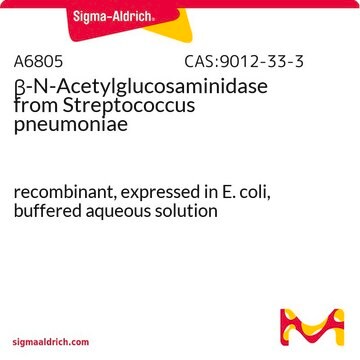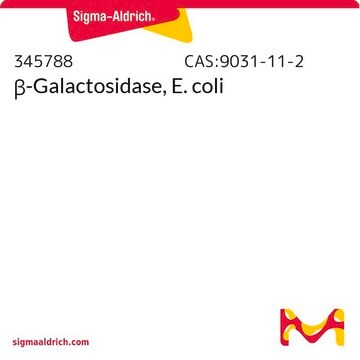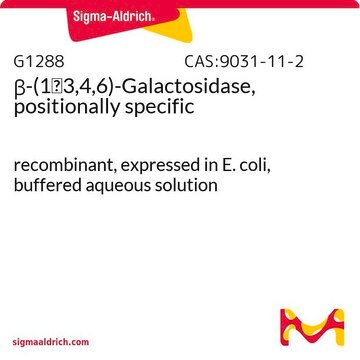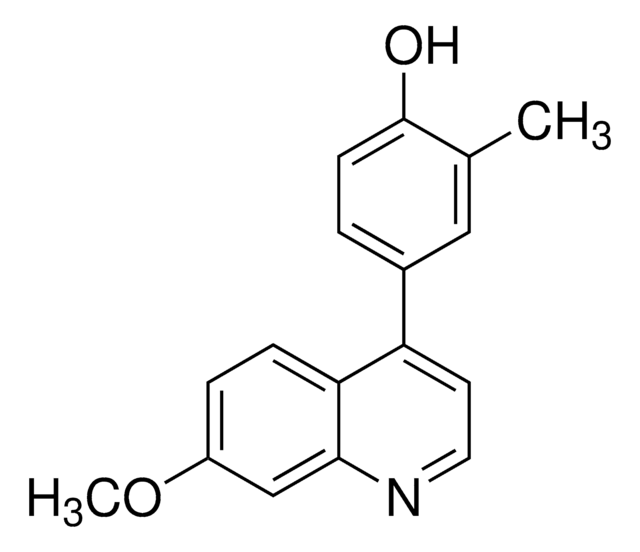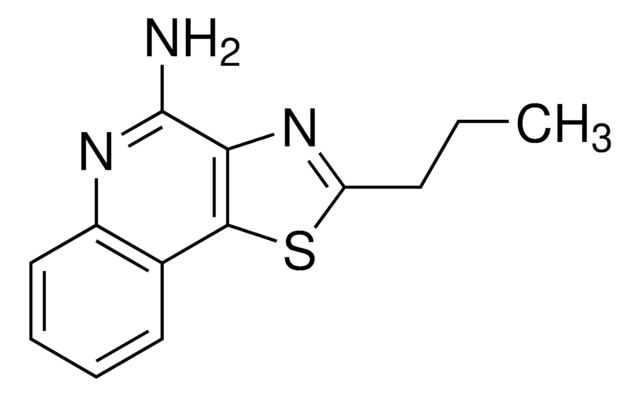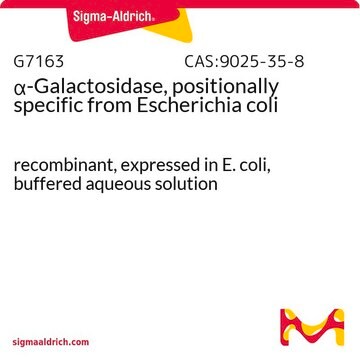G0413
β(1→4)-Galactosidase, positionally specific from Streptococcus pneumoniae
recombinant, expressed in E. coli, buffered aqueous solution
Sign Into View Organizational & Contract Pricing
All Photos(1)
About This Item
CAS Number:
MDL number:
UNSPSC Code:
12352204
NACRES:
NA.32
Recommended Products
recombinant
expressed in E. coli
Quality Level
form
buffered aqueous solution
specific activity
≥6 units/mg protein
packaging
vial of 0.06 unit
UniProt accession no.
shipped in
wet ice
storage temp.
2-8°C
Gene Information
human ... GLB1(2720)
General description
β-Galactosidase is present in bacteria, fungi, yeast and animal organs. It is also found in fruits, such as apples, almonds and apricots. β-Galactosidase is a tetramer and is made up of four polypeptide chains consisting of amino acids that assemble to form five structural domains. The domains are jelly roll barrel, a central domain that serves as an active site and the remaining domains are composed of β-sandwich and fibronectin.
Application
β(1→4)-Galactosidase, positionally specific from Streptococcus pneumonia has been used:
- as a position-specific enzyme to study its effects in the terminal galactosylation with protective efficacy of glycosphingolipid (GSPL) in mice.
- for the digestion of radioactive oligosaccharides.
- as a position-specific enzymeto study its effects on the virulence profile of avirulent Leishmania donovani clone (A-LD).
Biochem/physiol Actions
β-Galactosidase plays a role in hydrolyzing the D-galactosyl moieties in oligosaccharides, polymers and secondary metabolites. It is widely applicable in the dairy industry to remove lactose from milk and dairy products for the benefit of lactose-intolerant individuals. β-Galactosidase is also applicable in the food industry to improve the sweetness, flavor and solubility.
Unit Definition
One unit will hydrolyze 1 μmole of p-nitrophenyl β-D-galactopyranoside per min at pH 5.0 at 37 °C.
Physical form
Solution in 20 mM Tris-HCl, pH 7.5, 25 mM NaCl
Storage Class Code
10 - Combustible liquids
WGK
WGK 3
Flash Point(F)
Not applicable
Flash Point(C)
Not applicable
Choose from one of the most recent versions:
Already Own This Product?
Find documentation for the products that you have recently purchased in the Document Library.
Customers Also Viewed
Virulence attenuation of a UDP-galactose/N-acetylglucosamine beta1, 4 galactosyltransferase expressing Leishmania donovani promastigote
Bhaumik, SK , et al.
Glycoconjugate Journal, 25(5), 459-472 (2008)
Shaima Saqib et al.
3 Biotech, 7(1), 79-79 (2017-05-14)
The enzyme β-galactosidases have been isolated from various sources such as bacteria, fungi, yeast, vegetables, and recombinant sources. This enzyme holds importance due to its wide applications in food industries to manufacture lactose-hydrolyzed products for lactose-intolerant people and the formation
Sources of beta-galactosidase and its applications in food industry
Saqib S, et al.
3 Biotech, 7(1), 79-79 (2017)
beta Galactosidases and their potential applications: a review
Husain Q
Critical Reviews in Biotechnology, 30(1), 41-62 (2010)
Andrew J Hanneman et al.
Glycobiology, 16(9), 874-890 (2006-06-14)
Analysis of protein glycosylation within the nematode Caenorhabditis elegans has revealed an abundant and unreported set of core chitobiose modifications (CCMs) to N-linked glycans. With hydrazine release, an array of glycomers and isobars were detected with hexose extensions on the
Articles
Learn about O-linked glycan strategies, O-glycosidase actions, how to remove sialic acid residues, β-Elimination, and O-glycan modifications.
Our team of scientists has experience in all areas of research including Life Science, Material Science, Chemical Synthesis, Chromatography, Analytical and many others.
Contact Technical Service




